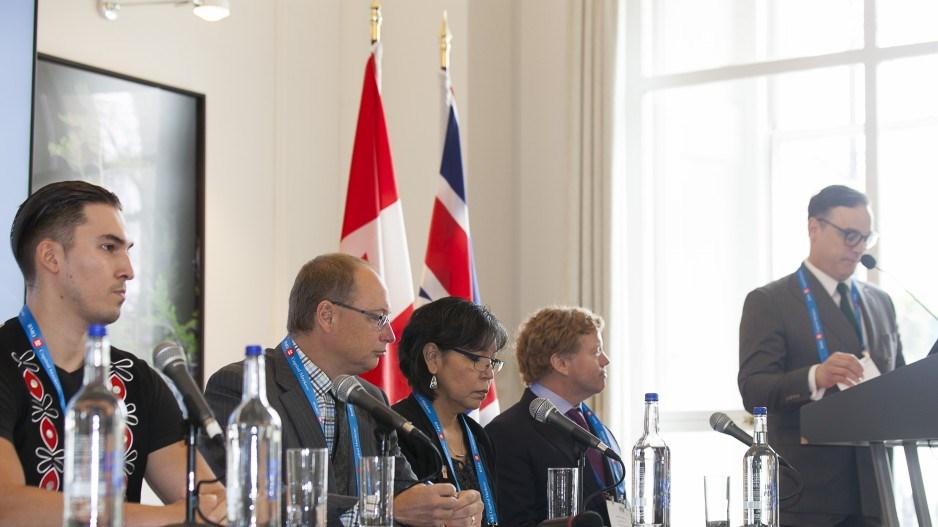Despite what international investors might have heard about B.C. being hostile to resource development, there is at least one corner of B.C. that welcomes resource industries, particularly mining.
And to drive the point home, a new partnership of government, industry and First Nations called the B.C. Regional Mining Alliance went to London to attend the Canadian Mining Symposium April 24 and 25 in a show of cooperation.
“What it’s all about is promoting B.C. as a great place for investing in mining and mineral exploration,” Energy, Mines and Petroleum Resources Minister Michelle Mungall told Business in Vancouver. “It’s the first time British Columbia government has ever done this.”
The alliance includes the Tahltan and Nisga’a Lisms Government, and its focus is primarily the Golden Triangle of northwest B.C. – a mineral-rich region that was opened to mining with the construction of the Northwest Transmission Line.
Industry members include the Association for Mineral Exploration, Dolly Varden Silver Corp., Skeena Resources Ltd. and GT Gold Corp.
One of the reasons the Pretium Resources Inc. (TSX:PVG) Brucejack mine was built in relatively short order was the support it had from the Tahltan and Nisga’a. Both signed a cooperation and benefits agreement with Pretium, which was able to put the mine into operation just two years after it received its environmental certificate.
Elsewhere in B.C., however, First Nation opposition has either stalled or killed other mining projects, including the New Prosperity mine – vigorously opposed by the Tsilhqot’in – and the $1.5 billion Ajax copper mine, which was killed earlier this year when the B.C. government declined the project an environmental certificate.
That rejection was based, in no small part, on resistance from the Stk'emlupsemc Te Secwepemc Nation (SSN) in Kamloops.
The B.C. NDP government has also formally adopted the United Nations Declaration on the Rights of Indigenous Peoples (UNDRIP). Some resource industries may be wondering what UNDRIP will mean for them, since it gives First Nations a greater say over what goes on in their traditional territories.
Those companies that have succeeded in developing projects in B.C. have generally been those that consulted early and earnestly with First Nations.
“We are in a new era of reconciliation with First Nations, where we must legally recognize their rights and title and the courts have been very clear on that,” Mungall said. “The way of doing business in the past is not the way of doing business in the future.
“The investment community was understandably cautious about investing in B.C. following the recent changes in provincial politics and the ongoing uncertainty with the implementation of UNDRIP,” said Chad Day, president of the Tahltan Central Government.
“However, the Tahltan Central Government has showcased several times in recent years that when all parties work through Tahltan processes and ensure our people have thorough oversight over the environment and are guaranteed significant benefits from economic development, there are clear paths to success for everyone."
Dave Nikolejsin, deputy minister of Energy, Mines and Petroleum Resources, said the rejection of a particular project like Ajax does not necessarily mean there is a general aversion to resource development among First Nations.
“Just because the SSN didn’t support Ajax doesn’t mean they don’t support mining, and this is mythology that we were there to bust,” he said.
“The SNN are huge supporters of mining. Just down the road, literally across the road from the Ajax project, is New Afton mine – a brand new underground major project. SSN’s totally involved, lots of employment, huge supports of that project. They support Highland Valley – the biggest copper mine in the province.”
He added that no one attending the London conference brought up the Ajax mine, and were glad to hear from First Nations themselves.
“People were much more interested in the going-forward question about ‘What’s going on with the regulatory environment, because we’re hearing these headline issues of you can’t get stuff through in B.C.?’” Nikolejsin said.
“And I can tell you, this is why the attendance of the First Nations were so powerful. The feedback was incredibly positive.”
Charlie Greig, vice president of exploration for GT Gold Corp., which has a gold exploration project in the Golden Triangle, said investors do ask about First Nations relationships, when the project is in B.C. It’s important, therefore, for companies like his to have the Nisga’a and Tahltan demonstrating their support for the mining and exploration industries.
“I think one of the things people, whether they’re in B.C. – particularly in southern B.C. – or anywhere else in the world needs to recognize is the size of our province,” Greig said. “It’s way bigger than many countries, so of course in different parts of it, projects of different natures are going to be differently received.”
Out of about a dozen potential mine projects identified in the Golden Triangle, two have been built to date: the Red Chris copper mine and the Brucejack gold mine.
Next in line is likely to be Red Mountain, a gold-silver mine being developed by IDM Mining Ltd. (TSX-V:IDM). The project is currently in the environmental review process.
“There’s other, I’d say, real going concerns,” Nikolejsin said. “There’s a company looking at the reopening of Snip and Eskay. Kutcho (copper) has work going on. There’s lots of continued exploration drilling going on with KSM.”




